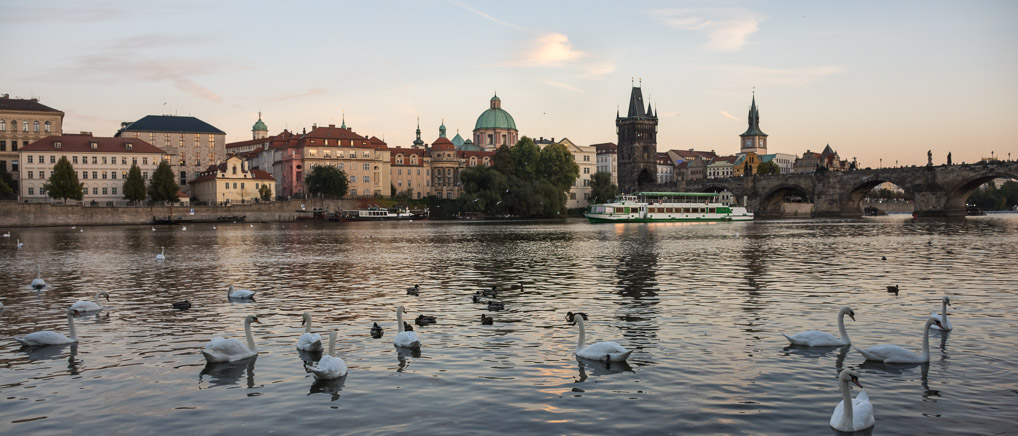Russ enjoys birds, although he’s really more interested in mammals and reptiles. I promised him monkeys in Panama, and I’m happy to report that I delivered on that promise. A small group of howlers (including mom w/baby) made their way through the trees as we finished breakfast.
The skies began to clear and we were finally able to get up on the observation deck. The upper level of the forest canopy is right at eye level from this vantage point. Birds began popping out of the foliage to forage and I started racking up some lifers (hurray!). We saw some little bitty guys with big names like Black-headed Tody-Flycatcher and Brown-capped Tyrannulet. Several jewel-toned hummingbirds flitted from tree to tree, and we also saw our first parrots and pigeons of the trip. A few of the guides were on-hand with their spotting scopes to help with ID and make sure everyone got good views of the birds.
Eventually Domi rounded us up for our scheduled morning activity; a walk down Semaphore Hill Road. We were joined by a friendly fellow guest from Kentucky for the outing.
The road basically functions as the Canopy Tower’s driveway. It’s the same narrow, winding route we had taken up the hill the previous afternoon to reach the lodge. We made a leisurely descent down its length, scanning through the thick trees for birds and other critters. Domi has excellent eyes and ears. He would hear the merest hint of a chip note and be able to find a tiny bird hidden in a tangle of vines. He’s also really good at mimicking a variety of bird calls to coax them out of hiding. Some of the morning’s highlights included Rufous, and Broad-billed Motmots, Fasciated Antshrikes, Keel-billed Toucans, and Masked Tityras.
Along the way, Domi pointed out various plant species and explained a little bit about how birds and animals utilized them. At one point,a couple of Geoffroy’s tamarins (Panama’s smallest monkey species) passed through the tall trees above our heads and an agouti (a ubiquitous rodent species in Central America) scampered across the road ahead of us. We also spent several minutes admiring some beautiful butterflies with electric-blue eyes that were working through flowers along the roadside.
What comes down must go back up… We had meandered our way roughly one mile down the steep, sometimes slippery drive. Lunchtime was looming and our Kentucky compadre wondered aloud if she would be able to make the climb back up Semaphore Hill (I quietly wondered the same thing on my own behalf). Never fear! Domi called the Tower and a vehicle was sent to haul us back up to the lodge. We made one brief stop along the way to see if the resident Panamanian night monkeys were in their roost tree. We had mentioned to Jenn the previous afternoon that we really hoped to see night monkeys during our week in Panama. The monkeys were not home that morning, but we appreciated the effort made to find them for us.
A nice lunch was waiting for us at the lodge. Meals at the Canopy Tower are not super fancy but there was always fresh fruit and salad offered, along with some sort of warm main course dish.
More howler monkeys moved past the dining room windows while we ate, and a three-toed sloth dangled upside-down in a nearby Cecropia tree.
After some post-lunch chill time, we set out once again with Domi and three other guests for an afternoon birding session. We piled into the back of a truck whose flatbed had been fitted with padded bench seats, and descended Semaphore Hill Road once again. Our first destination was the Summit Ponds; two small water bodies near the Summit Municipal Park (a well-known botanical garden and small zoo in the area). We were really hoping for a Boat-billed Heron, but birds do not show up on cue. We did see two awesome kingfisher species (Green, and the diminutive American Pygmy). And then the rainy drizzle began. Domi had us stow our camera equipment in the truck cab with him to keep it out of the elements. The rest of us donned our rain gear and huddled together in the open bed of the vehicle.
The rain eased by the time we reached the Ammo Dump Ponds (the name hearkens back to when the U.S. controlled the Panama Canal and stored ammunition for defense purposes nearby). This place was awesome! The birds were plentiful and many were new to me. Lapwings, jacanas, anis, kiskadees, tanagers… All were present and accounted for. One of my favorites of the afternoon was the secretive White-throated Crake (first spotted by Russ, who frequently finds birds before I do even though I’m the designated birder of the family!).
My very favorite species of the day was the Barred Antshrike with its bold stripes and punk-rock feathered crest. We also got great looks at a common basilisk (also known as the Jesus Christ lizard due to its ability to scurry across the surface of water).
On the drive back to the Tower, the rain resumed with a vengeance. We were thoroughly drenched, soaked, deluged; any watery descriptor you want to apply! Even my waterproof hiking shoes were soggy because the rain had run down my legs and into my socks. We got back to the lodge and sloshed our way up to our room for a much needed dry-off and clothing change.
We met with Domi before dinner to go over the bird and mammal list for the day. This is a fun recap of daily events that takes place each evening with whichever guide(s) you spent time with.
We enjoyed a pleasant meal, trading stories of the day’s activities with our table-mates, and then it was off to bed by 10:00 p.m. (birding lends itself to the “early to bed, early to rise” mentality!).













